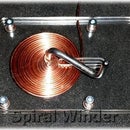Introduction: Intel IoT Prelude #1, Tame That Tiger
Nobody likes a cry baby, so here's how I muffled the little bugger - It might work for you too.
Step 1: Why Oh Why
This is meant to help you keep your sanity, in case you got the Grove F280 gear motors for the Intel IoT Invitational (Robot Kit) and it bit your ears with a shrieking ear splitting whine.
That said, it will work for other types of motors as well (of course) and so, may be helpful to anyone with a mechanically noisy motor.
Step 2: The F280 Planet Gear Motor
As can be seen in the photo, the F280 consists of a fairly mediocre DC motor, as found in lots of cheap toys, with an added gear box. While the motor itself is of a less than optimal manufacture, the gear box is quite good and brings the assembly into what I'd call a decent job.
But I had to get it to behave, as even with my severely damaged high frequency hearing (too much Rock'N'Roll and gun firing), I was close to hitting it with something hard... And so my quest for The Sound of Silence began, on a warm summer day, where I really ought to be vegetating in a hammock, with ample supplies of Scotch&Coke.
Step 3: Components of the Gear Box
I started by stripping down the gear box, to find what part exactly was making the noise. Be very careful if you do this and keep it over something that will catch parts falling off the gear box. You need them all for the reassembly - it's not a car
In the photo above, you can see all the parts. Top left is the motor (standing, with its drive axle pointing towards you) and in the second row is a washer, the first stage of the gear (the side with the nylon spur gears is in contact with the motor gear when assembled, A single gear wheel is on its other side) and the housing containing the second stage (with the output axle pointing away from you). Lower left is the mounting ring that is bolted on the motor body with two (inhexc head) screws (still in the relevant holes) and has got 3 threaded holes for the 3 (Philips head) screws (middle of pic) that holds the gearbox to the mounting ring.
Overall, it's a pretty OK gear box, but if you need to dismantle the gear box for any reason, consider adding a tiny amount of grease suitable for nylon and steel, if it was assembled with as little grease as mine was, but don't overdo it, or you'll slow down the motor too much - just a thin film of grease on each gear wheel will make it run more silent, while too much will just sit there and do no good.
Step 4: A Closer Look
Just for those who like a better look at the parts, here's the motor housing with the gear wheel towards you and showing the two threaded holes for the mounting ring. Then comes the first gear stage, with a washer and a metal gear wheel pointing down/away. This gear wheel engages the 3 steel gear wheels, of the second stage, that can be seen in the housing. The D-shaped output shaft pointing away, is part of the plate/disc carrying the gear wheels of the second stage. Finally is the mounting ring that interfaces motor and gear box - It came that way, so I snapped the pics before I cleaned it up!
Step 5: Gear Box Cleared, Source of Noise Found and Terminated
With the motor as bare naked as it was born, I spun the motor by its shaft and even with no electric power, it shrieked, so I reached for a bit of steel to make an opener/mini crow bar, to open the motor housing, but before I was done grinding, a naughty thought entered my mind... Let's lube up the thing and see if that will help.
Adding a tiny drop of Super Lube(TM), a thin synthetic lube loaded with microscopic PTFE/Teflon balls, to the (bronze) output bushing and powering up brought the sunshine indoors, as the motor now ran with no trace of shreaking, loaded, unloaded and over the entire voltage range (3V..24V).
As an added precaution, I gave the other end of the axle a small drop as well (Murphy hits those who doesn't prepare ;))
See photos for the exact places to lube. If you haven't got any PTFE lube, sewing machine oil should do the trick.
Reassembled the gearbox and ran the entire assembly, now with no tears on my behalf. Job done, hammock calling.
Step 6: Cogitare Et Bibens
I made recordings of the sound, before and after, with the same setup (distance, sensitivity etc.) and I can post them if anyone is interested, although I'd have to convert them first, as I recorded in 24 bit at 96 kHz, so if nobody cares...
Next up: Probably a look at the electrical noise of the F280 and how to curb it, to avoid interference (and hence limited range), with WiFi, Bluetooth and what radio modules that you might decide to add.
Omnivent back to the hammock, fulfilling the purpose of life








![Tim's Mechanical Spider Leg [LU9685-20CU]](https://content.instructables.com/FFB/5R4I/LVKZ6G6R/FFB5R4ILVKZ6G6R.png?auto=webp&crop=1.2%3A1&frame=1&width=306)




